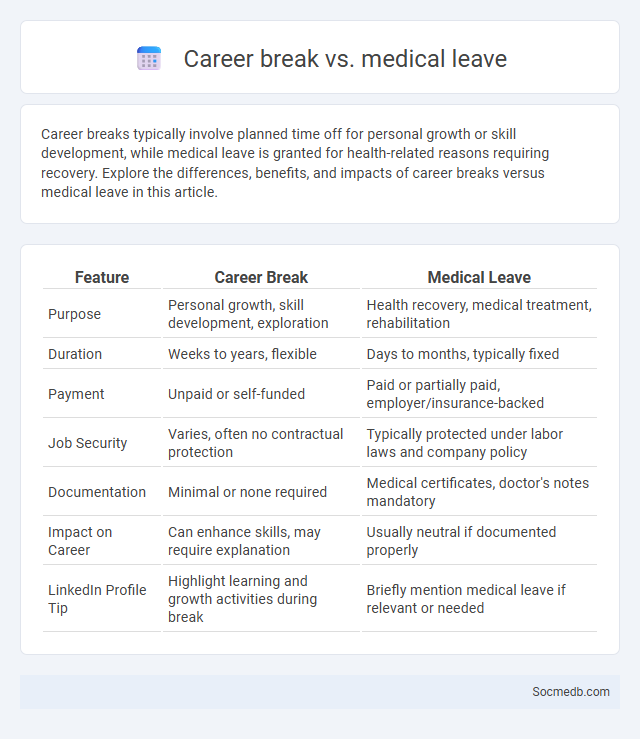
Photo illustration: Career break vs Medical leave
Career breaks typically involve planned time off for personal growth or skill development, while medical leave is granted for health-related reasons requiring recovery. Explore the differences, benefits, and impacts of career breaks versus medical leave in this article.
Table of Comparison
| Feature | Career Break | Medical Leave |
|---|---|---|
| Purpose | Personal growth, skill development, exploration | Health recovery, medical treatment, rehabilitation |
| Duration | Weeks to years, flexible | Days to months, typically fixed |
| Payment | Unpaid or self-funded | Paid or partially paid, employer/insurance-backed |
| Job Security | Varies, often no contractual protection | Typically protected under labor laws and company policy |
| Documentation | Minimal or none required | Medical certificates, doctor's notes mandatory |
| Impact on Career | Can enhance skills, may require explanation | Usually neutral if documented properly |
| LinkedIn Profile Tip | Highlight learning and growth activities during break | Briefly mention medical leave if relevant or needed |
Understanding Career Breaks: Definition and Types
Career breaks refer to intentional pauses in Your professional journey, encompassing various types such as sabbaticals, parental leave, personal development, or health-related breaks. These periods allow individuals to recharge, pursue new skills, or address life circumstances without resigning permanently. Recognizing the different types of career breaks helps optimize your resume and career planning for future opportunities.
What Constitutes Medical Leave? Key Features
Medical leave constitutes authorized time off from work due to illness, injury, or medical treatment, ensuring employees receive necessary rest and recovery. Key features include documentation requirements such as medical certificates, the duration often depends on the severity of the condition, and legal protections under labor laws to prevent job loss during the leave. Your ability to access medical leave is essential for maintaining health without jeopardizing employment status.
Differences Between Career Break and Medical Leave
Career breaks involve voluntarily pausing work for personal growth, travel, or education, while medical leave is a legally protected absence due to health issues or recovery. Social media usage during career breaks often centers on personal branding, skill-building, and networking, whereas medical leave posts typically focus on health updates, support seeking, and awareness. Employers generally require medical certification for medical leave, but career breaks are negotiated based on individual agreements and lack formal medical validation.
Legal Implications: Rights and Protections
Social media platforms operate under complex legal frameworks that protect users' rights such as freedom of expression and privacy while also enforcing regulations against defamation, harassment, and intellectual property infringement. Laws like the General Data Protection Regulation (GDPR) and the Digital Millennium Copyright Act (DMCA) impose strict guidelines on data handling and content management, ensuring accountability for both platforms and users. Understanding these legal implications is crucial for navigating rights and protecting digital content in an increasingly connected online environment.
Financial Impacts: Salary, Benefits, and Support
Social media careers offer competitive salaries that vary based on experience and platform specialization, with entry-level positions typically starting around $50,000 annually and senior roles exceeding $120,000. Benefits often include health insurance, retirement plans, and performance bonuses that enhance overall compensation packages. Your ability to leverage social media skills can also secure access to professional development support and flexible work arrangements that contribute to long-term financial growth.
Returning to Work: Re-entry Strategies
Effective re-entry strategies for returning to work after a social media hiatus involve gradually increasing your professional online presence and updating your profiles to reflect current skills and achievements. Engaging with industry-relevant content and participating in discussions rebuilds your network and visibility, enhancing opportunities for collaboration and career growth. Prioritize consistency in posting and authenticity in your interactions to maximize your social media impact and re-establish your professional brand.
Employer Policies and Expectations
Employer policies for social media usage often include guidelines on professional conduct, confidentiality, and the representation of the company's brand. Clear expectations help mitigate risks associated with inappropriate posts and ensure that Your online presence aligns with organizational values. Adhering to these policies protects both Your reputation and the employer's integrity in the digital landscape.
Addressing Mental and Physical Health Needs
Social media platforms offer valuable resources and communities that support mental and physical health needs by providing access to expert advice, peer support, and mental wellness tools. Engaging with carefully curated content can help you manage stress, develop healthy habits, and stay informed about physical fitness and mental health strategies. Tailoring your social media experience to include credible health sources enhances your well-being and empowers you to prioritize both mental and physical self-care effectively.
Navigating Stigma and Perceptions in the Workplace
Social media use in the workplace often faces stigma due to concerns about productivity and professionalism, impacting employees' behavior online. Understanding employer perceptions and implementing clear social media policies can help balance personal expression with organizational expectations. Educating both management and staff on responsible social media engagement promotes a healthier work environment and reduces negative judgments.
Choosing the Right Option: Factors to Consider
Choosing the right social media platform depends on understanding the target audience demographics and the specific goals of the campaign, such as brand awareness, lead generation, or customer engagement. Analyzing platform features like content format compatibility, advertising options, and user engagement rates helps in optimizing reach and impact. Budget constraints and available resources also play a crucial role in selecting a sustainable social media strategy that aligns with business objectives.
 socmedb.com
socmedb.com